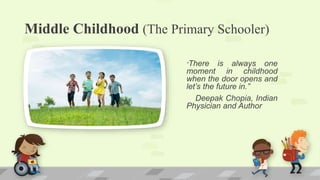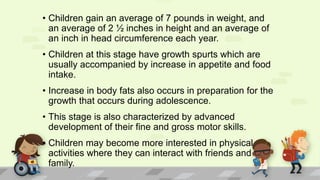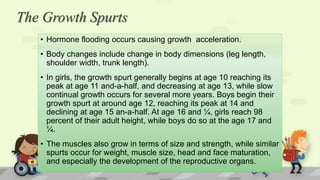Child and Adolescents
- 1. Physical and Motor Development of Children and Adolescents
- 2. Early Childhood (The Preschooler) “A child reminds us that playtime is an essential part of our daily routine.” Anonymous
- 3. Big Ideas About the Physical Development of Preschoolers 1. There are significant changes in physical growth of preschoolers. • Physical growth increases, but slower in pace than in infancy and toddlerhood. • Preschoolers have their center of gravity at a lower level that gives them more ability to be stable and balanced than the toddler. • By the time the child reaches three years old, all primary or deciduous teeth are already in place.
- 4. 2. The preschooler’s physical development is marked by the acquisition of gross and fine motor skills. Gross motor development Fine motor development refers to acquiring skills that involve the large muscles. refers to acquiring the ability to use the smaller muscles in the arm, hands and fingers purposefully. • Locomotor skills • Non-locomotor skills • Manipulative skills Preschoolers are generally physically active. Level of activity is highest around three and becomes a little less as the preschooler gets older.
- 5. 3. Preschoolers can express themselves artistically at a very early age. • At the heart of the preschooler years is their interest to draw and make other forms of artistic expressions. This form of fine motor skills is relevant to preschoolers. Viktor Lowenfeld’s stages of drawing in early childhood: Stage 1. Scribbling Stage Stage 2. Preschematic Stage Stage 3. Schematic Stage • It is important to remember that the preschooler’s representations or drawings does not only involve fine motor skills, but also cognitive skills.
- 6. 4. Proper nutrition and the right amount of sleep are very important for the preschoolers. • The kind of nutrition a preschooler gets has a far- reaching effect on physical growth and development. The preschooler’s nutritional status is the result of what nutrients he or she actually takes in checked against the nutritional requirement for his age. • Preschooler’s benefit from about 10-12 hours of sleep each day. It is during sleep that vital biological processes that affect physical and cognitive development take place.
- 7. 5. Caregivers and teachers can do a lot in maximizing the growth and development of preschoolers. • Optimum physical development of preschoolers is largely influenced by the supportive caregivers (parents and teachers) who provide a stimulating environment and appropriate activities for the children. 6. Preschoolers with special needs in inclusive classrooms can thrive well with the appropriate adaptations made in classroom, materials, and activities.
- 8. Middle Childhood (The Primary Schooler) “There is always one moment in childhood when the door opens and let’s the future in.” Deepak Chopia, Indian Physician and Author
- 9. • Physical development during the primary school years is slow but steady. • At this stage, physical development includes: • (1) having good muscle control and coordination, • (2) developing eye-hand coordination, • (3) having good personal hygiene and • (4) being aware of good safety habits.
- 10. Height and Weight • An average increase in height of a little over two inches a year in both boys and girls will introduce them to many different activities that they can now do with greater accuracy. • Weight gain averages about 6.5 pounds a year. • A number of factors could indicate how much a child changes grows, or how much changes in the body will take place: Genes Food Climate Exercise Medical Conditions Diseases/illness
- 11. Bones and Muscles • Childhood years are the peak bone- producing years. • Skeletal bones and muscles broaden and lengthen. Skeletal growth in middle childhood is also associated with losing the deciduous teeth, or baby teeth. • Throughout middle childhood girls are smaller than boys and have less muscle mass.
- 12. Motor Development • Young school-aged children are gaining control over the major muscles of their bodies. • Most children have a good sense of balance . • Children at thus stage love to move a lot. • Performing unimanual and bi-manual activities becomes easier. • Children's graphic activities are now more controlled but still are developing. • Motor development skills include coordination, balance, speed, agility and power.
- 13. Late Childhood ( The Intermediate Schooler) “The period of late childhood is the period of calm before the growth spurt of adolescence.” Anonymous
- 14. Physical Changes • On the average, girls are generally as much as two years ahead of boys in terms of physical maturity. • Puberty may begin early. • Many of the bodily structures like the liver, muscles, skeletons, kidneys and face follow a normal curve of development for both boys and girls. • Other structures like the brain, intestines and other organs and bodily systems mature at their own time, thus, affecting growth patterns.
- 15. • Children gain an average of 7 pounds in weight, and an average of 2 ½ inches in height and an average of an inch in head circumference each year. • Children at this stage have growth spurts which are usually accompanied by increase in appetite and food intake. • Increase in body fats also occurs in preparation for the growth that occurs during adolescence. • This stage is also characterized by advanced development of their fine and gross motor skills. • Children may become more interested in physical activities where they can interact with friends and family.
- 16. Adolescence ( The High School Learners) “Adolescence is just one big walking pimple.” Carol Burnett
- 17. Pubertal Changes Biological change comprises the major transition from childhood to early adolescence, manifested by change in physical appearance and a more rapid rate of development.
- 18. The Growth Spurts • Hormone flooding occurs causing growth acceleration. • Body changes include change in body dimensions (leg length, shoulder width, trunk length). • In girls, the growth spurt generally begins at age 10 reaching its peak at age 11 and-a-half, and decreasing at age 13, while slow continual growth occurs for several more years. Boys begin their growth spurt at around age 12, reaching its peak at 14 and declining at age 15 an-a-half. At age 16 and ¼, girls reach 98 percent of their adult height, while boys do so at the age 17 and ¼. • The muscles also grow in terms of size and strength, while similar spurts occur for weight, muscle size, head and face maturation, and especially the development of the reproductive organs.
- 19. Sexual Maturity FEMALE MALE the growth of the ovaries testis growth of pubic hair growth of pubic hair development of breasts growth of facial hair • Menarche is the beginning of the menstrual cycle for female. • Spermarche is the first ejaculation of semen containing ejaculate for the males. • The most dramatic sign of sexual maturation for girls is the menstruation. • The principal sign of sexual maturation in boys is the sperm in the urine. The triggering by hormones of the hypothalamus glands on hormones of the pituitary gland signals the entire process of sexual maturation. Primary sex characteristics Second changes
- 20. Adolescent Sleeping Habits • Adolescent sleeping habits Studies show that teenagers are not getting enough sleep, and would want more sleep. Shorter sleep contributes to increased levels of depression, daytime sleepiness, and problems with sleeping.
- 21. Exploration •Instinctively , adolescents become aware of changes in sexuality, thus undergoing a period of exploration and adjustment.
- 22. Adolescents and Nutrition • Necessary for adolescent years are sufficient amounts of vitamin B12(found in animal proteins), calcium, zinc, iron, riboflavin and vitamin D.
- 23. References: Corpuz, Brenda B., et. al.,(2010), Child and Adolescent Development, pp.186-197, 239-243, 263-267, 291-297. Acero, Victorina D., et. Al., Child and Adolescent Development, pp.12-15.
Editor's Notes
- #2: Discussants: Alva Pabello and Iris Españo (Tacloban City)























